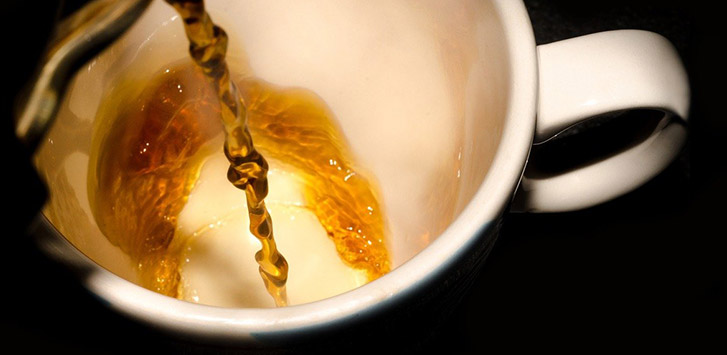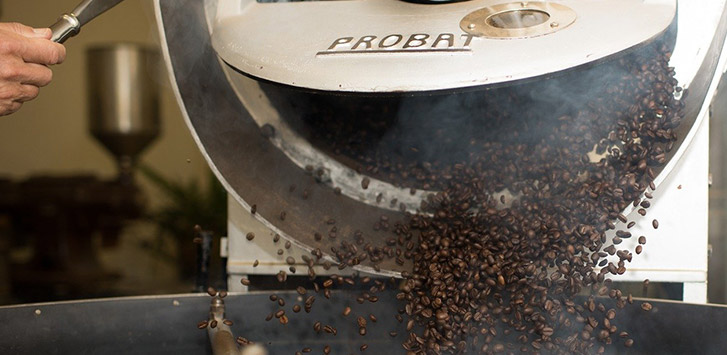What we think of white coffee is a relatively newer fad of specialty coffees for European and American coffee drinkers. A lighter cup of coffee with an upfront acidity and pronounced nutty flavors, the “Western” idea of what white coffee differs from others that exist in places like Malaysia or Yemen.
This type of coffee is a pleasant and interesting twist to try out if you are looking for a new horizon of flavor to enjoy in your morning cup. The best part about white coffee is that you can even make it yourself!
What is White Coffee Exactly?
White coffee is just like any other coffee bean, whether Arabica or Robusta. What does matter is how the coffee bean is roasted. It is created by roasting the coffee beans at a lower temperature and about “halfway through” prior to the first crack in the roasting process which gives the green coffee beans its characteristic acidity and flat “white” color.
The Origin of White Coffee
While the white coffee we are talking about is a relatively new phenomenon in Western circles, a similarly made coffee drink has existed in Yemen for centuries where the beans are roasted at a lower temperature, ground, brewed, and then mixed with a spice blend called hawaij. A version of the Yemeni drink exists in Lebanon as well.

There is also another variant that exists in Indonesia and Malaysia. The Ipoh white coffee of Malaysia is made by roasting the coffee beans in palm oil and then brewed into a standard black coffee to which condensed milk is stirred into the drink, making the drink look white.
How is White Coffee Made and How Can You Make It Yourself?

White coffee is made by roasting coffee beans at a lower temperature, specifically around 325°F, compared to a traditional roasting temperature of anywhere between 370 to 540°F. On top of a lower overall roast temperature, white coffee has a lower overall roasting time as well.
In essence, you are half-roasting the coffee bean. Whereas most light roasted coffees stop being roasted after the first crack, white coffees are pulled just before that occurs. Because of this roasting method, the coffee beans are still very dense and very hard, making the task of grinding them with anything less than a commercial coffee grinder nearly impossible. But if you do not mind putting in a bit of elbow grease, grab your mortar and pestle and grind away the old-fashioned way.
How to Brew White Coffee
After roasting and grinding the beans, the biggest question remains of what exactly to do with these special beans. Well, it depends upon how finely you decided to grind your coffee beans. If you ground them pretty finely, making an espresso is one option. On the other hand, if your grind is a bit coarser, the other option is to create a coffee blend with another coffee bean that would complement white coffee’s nutty flavor.
Due in part to the lower temperatures of home coffee brewers, combing the white coffee grounds into another appropriate bean will create a better-brewed cup of coffee. If brewed by itself, the white coffee grounds will appear more translucent and not have the “usual body” that most are used to with a regular cup of coffee.
How Does White Coffee Taste?
This is a tricky question to answer as there is not a standard coffee bean used to make white coffee. Usually, the taste is like light roasts with its strong acidity and nuttiness.
Depending on what type of bean you decide to roast with, the flavors that come forward during the roasting period are “up in the air” in a sense. Do you like aromatic Sumatrans? Or what about subtle Ethiopians? Any bean you already enjoy is a perfect candidate for roasting.
Does White Coffee Have More Caffeine than Black Coffee?
While white coffee is often marketed as highly caffeinated when compared to “regular”, black coffee, white coffee does not have any more caffeine than any other lighter roasts. This idea comes from the theory that as coffee is roasted, it loses caffeine by volume, therefore, logically it follows that very lightly roasted coffee will have more caffeine.
And in some sense, caffeine loss does occur during the roasting process from light to dark roasts. However, the caffeine loss is so minimal that to even market any specific light roast as having a greater caffeine content than any dark roast is just a marketing gimmick.
Are There Any Health Benefits to Drinking White Coffee?
While the claim of having more caffeine than a traditional cup of coffee may be untrue, white coffee does indeed boast more health benefits than traditional black coffee.
This is due to the unique roasting process. Because of the extremely light roast the beans undergo, they hold onto more chlorogenic acid, which boosts antioxidant activity among other added health benefits. It has also been shown to reduce hypertension, stimulate weight loss, reduce the risk of diabetes, and more.
Conclusion
White coffee may mean different things to different people, whether it’s the Yemeni version of white coffee with its unique spice blend or the Malaysian Ipoh drink with its sweetened condensed milk, but the Western fad of extremely light roasted coffee beans is a newer trend within the coffee world that is surrounded by both fact and fiction.
This unique way of roasting presents new opportunities for experienced coffee drinkers, coffee shops, and coffee newbies alike to further experiment and find new realms of flavor within the coffee world with a coffee bean that isn’t limited to just a specific country or geographical region, but rather a challenging roasting style the presents new ways of experience coffee. Try roasting it yourself and let us know your results and thoughts on this interesting roasting style.